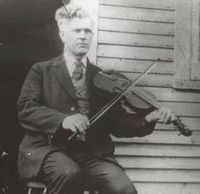Annotation:Gigue du Forgeron (1): Difference between revisions
m (Text replacement - "garamond, serif" to "sans-serif") |
m (Andrew moved page Annotation:Gigue du Forgeron to Annotation:Gigue du Forgeron (1)) |
(No difference)
| |
Revision as of 16:45, 18 November 2020
Back to Gigue du Forgeron (1)
GIGUE DU FORGERON (Blacksmith's Dance). AKA and see "Reel du Forgeron." French-Canadian, Jig. D Major. Standard tuning (fiddle). AA'BB'. Recorded by Québec fiddler Joseph Allard [1] [2] in 1937. See also the closely related "Doc Boyd's Jig," a 1933 composition by Ontario fiddler John Burt, of which "Gigue du Forgeron" may be a derivative. A gigue in Québec is a stepdance, and the name attached to a tune simply means a vehicle for stepdancing, no matter what the meter.

See also "Republican Set (The)", printed by Bayard (1981), and "Old Jubiter" in Ford's collection (1940). The jig seems to have been widespread in the northern United States and Great Lakes region, as well as in Canada, albeit under no predominant or fixed title.
Source for notated version: Joseph Allard (1873-1947, Woodland, Montréal, Québec) [Cuillerier, Hart & Sandell].
Printed sources: Cuillerier (Joseph Allard), 1992; p. 9. Hart & Sandell (Dance ce Soir), 2001; No. 12, pp. 45-46.
Recorded sources: Bluebird B-1104-a (78 RPM), Joseph Allard (1937).
See also listing at:
Eric Lortie's Indentitairs Québécois [3]
Hear Allard's version at The Virtual Gramaphone [4]
